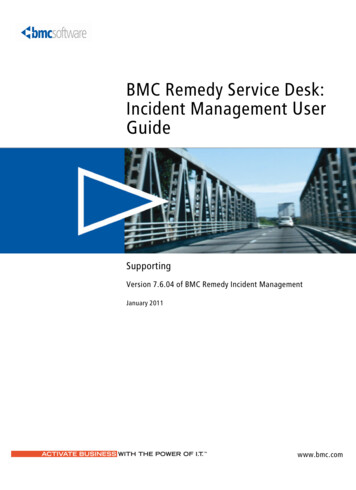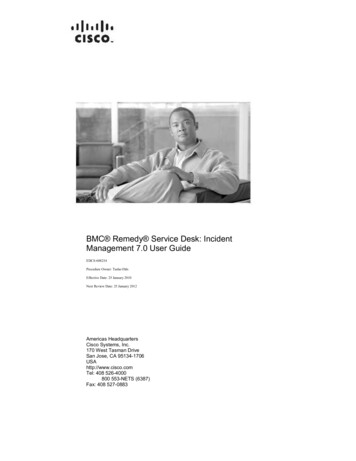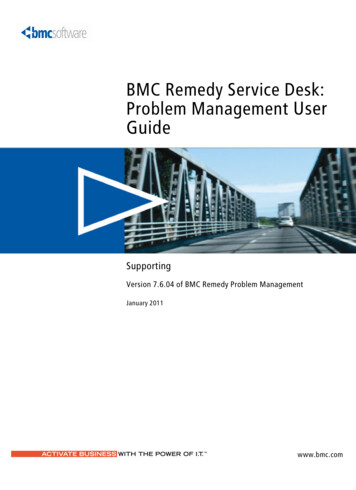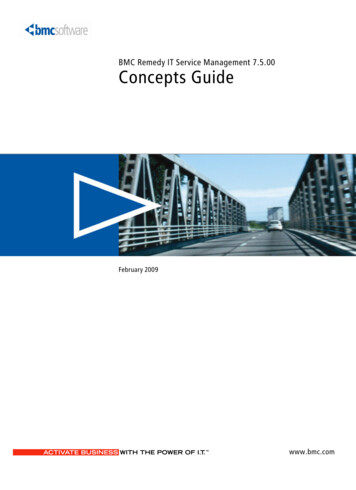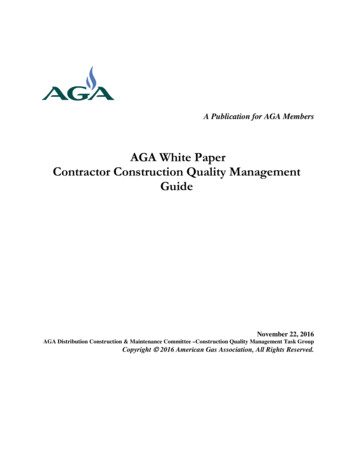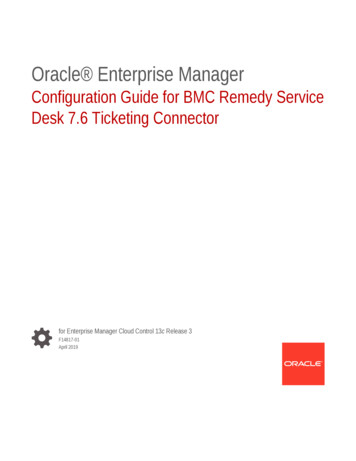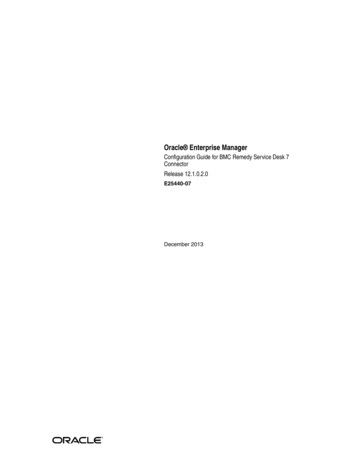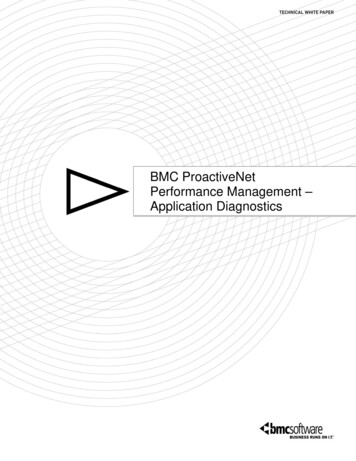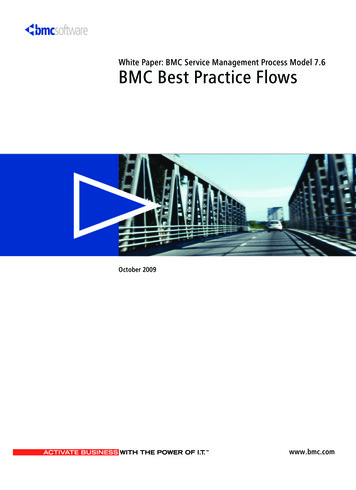
Transcription
White Paper: BMC Service Management Process Model 7.6BMC Best Practice FlowsOctober 2009www.bmc.com
Contacting BMC SoftwareYou can access the BMC Software website at http://www.bmc.com. From this website, you can obtain informationabout the company, its products, corporate offices, special events, and career opportunities.United States and CanadaAddressBMC SOFTWARE INC2101 CITYWEST BLVDHOUSTON TX 77042-2827USATelephone713 918 8800 or800 841 2031Fax(01) 713 918 8000Fax713 918 8000Outside United States and CanadaTelephone(01) 713 918 8800If you have comments or suggestions about this documentation, contact Information Design and Development by email atdoc feedback@bmc.com. Copyright 2009 BMC Software, Inc.BMC, BMC Software, and the BMC Software logo are the exclusive properties of BMC Software, Inc., are registered with the U.S. Patentand Trademark Office, and may be registered or pending registration in other countries. All other BMC trademarks, service marks, andlogos may be registered or pending registration in the U.S. or in other countries. All other trademarks or registered trademarks are theproperty of their respective owners.BMC Software considers information included in this documentation to be proprietary and confidential. Your use of this information issubject to the terms and conditions of the applicable End User License Agreement for the product and the proprietary and restrictedrights notices included in this documentation.Restricted rights legendU.S. Government Restricted Rights to Computer Software. UNPUBLISHED -- RIGHTS RESERVED UNDER THE COPYRIGHT LAWS OFTHE UNITED STATES. Use, duplication, or disclosure of any data and computer software by the U.S. Government is subject torestrictions, as applicable, set forth in FAR Section 52.227-14, DFARS 252.227-7013, DFARS 252.227-7014, DFARS 252.227-7015, andDFARS 252.227-7025, as amended from time to time. Contractor/Manufacturer is BMC Software, Inc., 2101 CityWest Blvd., Houston, TX77042-2827, USA. Any contract notices should be sent to this address.
Customer SupportYou can obtain technical support by using the Support page on the BMC Software website or by contacting CustomerSupport by telephone or email. To expedite your inquiry, please see “Before Contacting BMC Software.”Support websiteYou can obtain technical support from BMC Software 24 hours a day, 7 days a week athttp://www.bmc.com/support. From this website, you can: Read overviews about support services and programs that BMC Software offers.Find the most current information about BMC Software products.Search a database for problems similar to yours and possible solutions.Order or download product documentation.Report a problem or ask a question.Subscribe to receive email notices when new product versions are released.Find worldwide BMC Software support center locations and contact information, including email addresses, faxnumbers, and telephone numbers.Support by telephone or emailIn the United States and Canada, if you need technical support and do not have access to the Web, call 800 537 1813 orsend an email message to customer support@bmc.com. (In the Subject line, enterSupID:yourSupportContractID, such as SupID:12345.) Outside the United States and Canada, contact yourlocal support center for assistance.Before contacting BMC SoftwareHave the following information available so that Customer Support can begin working on your issue immediately: Product information——— Product nameProduct version (release number)License number and password (trial or permanent)Operating system and environment information—————Machine typeOperating system type, version, and service packSystem hardware configurationSerial numbersRelated software (database, program, and communication) including type, version, and service pack ormaintenance level Sequence of events leading to the problem Commands and options that you used Messages received (and the time and date that you received them)———Product error messagesMessages from the operating system, such as file system fullMessages from related software
License key and password informationIf you have a question about your license key or password, contact Customer Support through one of the followingmethods: E-mail customer support@bmc.com. (In the Subject line, enter SupID:yourSupportContractID, suchas SupID:12345.) In the United States and Canada, call 800 537 1813. Outside the United States and Canada, contact your local supportcenter for assistance. Submit a new issue at http://www.bmc.com/support.
ContentsPrefaceChapter 17Availability Management9Procedure 1, Service Infrastructure Design . . . . . . . . . . . . . . . . . . . . . . . . . . . . . . . . . . . 10Procedure 2, Availability Tracking . . . . . . . . . . . . . . . . . . . . . . . . . . . . . . . . . . . . . . . . . . 12Chapter 2Capacity Management15Procedure 1, Capacity Utilization Threshold Setting . . . . . . . . . . . . . . . . . . . . . . . . . . . 16Procedure 2, Capacity Warning Handling . . . . . . . . . . . . . . . . . . . . . . . . . . . . . . . . . . . . 17Procedure 3, Capacity Tracking . . . . . . . . . . . . . . . . . . . . . . . . . . . . . . . . . . . . . . . . . . . . . 19Chapter 3Change Management21Procedure 1, Request for Change Review . . . . . . . . . . . . . . . . . . . . . . . . . . . . . . . . . . . .Procedure 2, Change Planning. . . . . . . . . . . . . . . . . . . . . . . . . . . . . . . . . . . . . . . . . . . . . .Procedure 3, Change Approval . . . . . . . . . . . . . . . . . . . . . . . . . . . . . . . . . . . . . . . . . . . . .Procedure 4, Infrastructure Change Implementation. . . . . . . . . . . . . . . . . . . . . . . . . . .Procedure 5, Application Change Implementation . . . . . . . . . . . . . . . . . . . . . . . . . . . .Procedure 6, Planned Change Closure . . . . . . . . . . . . . . . . . . . . . . . . . . . . . . . . . . . . . . .Procedure 7, Emergency Change Implementation . . . . . . . . . . . . . . . . . . . . . . . . . . . . .Procedure 8, Emergency Change Closure . . . . . . . . . . . . . . . . . . . . . . . . . . . . . . . . . . . .2224252829303133Chapter 435Configuration ManagementProcedure 1, CI Requisition . . . . . . . . . . . . . . . . . . . . . . . . . . . . . . . . . . . . . . . . . . . . . . . .Procedure 2, Supplier Information Maintenance . . . . . . . . . . . . . . . . . . . . . . . . . . . . . .Procedure 3, CI Registration. . . . . . . . . . . . . . . . . . . . . . . . . . . . . . . . . . . . . . . . . . . . . . . .Procedure 4, CI Update . . . . . . . . . . . . . . . . . . . . . . . . . . . . . . . . . . . . . . . . . . . . . . . . . . . .Procedure 5, Contract Administration . . . . . . . . . . . . . . . . . . . . . . . . . . . . . . . . . . . . . . .3638394041Chapter 543Continuity ManagementProcedure 1, Disaster Notification Handling. . . . . . . . . . . . . . . . . . . . . . . . . . . . . . . . . .Procedure 2, Service Recovery . . . . . . . . . . . . . . . . . . . . . . . . . . . . . . . . . . . . . . . . . . . . . .Procedure 3, Return to Production . . . . . . . . . . . . . . . . . . . . . . . . . . . . . . . . . . . . . . . . . .Procedure 4, Service Recovery Testing . . . . . . . . . . . . . . . . . . . . . . . . . . . . . . . . . . . . . . .Procedure 5, Continuity Manual Maintenance . . . . . . . . . . . . . . . . . . . . . . . . . . . . . . . .Procedure 6, Continuity Plan Maintenance . . . . . . . . . . . . . . . . . . . . . . . . . . . . . . . . . . .Contents4446474951535
Chapter 6Event Management55Procedure 1, Event Handling . . . . . . . . . . . . . . . . . . . . . . . . . . . . . . . . . . . . . . . . . . . . . . . 56Procedure 2, Event Review . . . . . . . . . . . . . . . . . . . . . . . . . . . . . . . . . . . . . . . . . . . . . . . . . 57Procedure 3, Outage Review. . . . . . . . . . . . . . . . . . . . . . . . . . . . . . . . . . . . . . . . . . . . . . . . 58Chapter 7Financial Management61Procedure 1, Accounting & Charging . . . . . . . . . . . . . . . . . . . . . . . . . . . . . . . . . . . . . . . . 62Procedure 2, Financial Review . . . . . . . . . . . . . . . . . . . . . . . . . . . . . . . . . . . . . . . . . . . . . . 63Procedure 3, Budgeting . . . . . . . . . . . . . . . . . . . . . . . . . . . . . . . . . . . . . . . . . . . . . . . . . . . . 64Chapter 8Incident Management67Procedure 1, Incident Request Registration . . . . . . . . . . . . . . . . . . . . . . . . . . . . . . . . . . . 68Procedure 2, Incident Request Assignment . . . . . . . . . . . . . . . . . . . . . . . . . . . . . . . . . . . 69Procedure 3, Incident Request Tracking . . . . . . . . . . . . . . . . . . . . . . . . . . . . . . . . . . . . . . 71Procedure 4, Incident Request Resolution by Specialist . . . . . . . . . . . . . . . . . . . . . . . . . 72Procedure 5, Incident Escalation Handling . . . . . . . . . . . . . . . . . . . . . . . . . . . . . . . . . . . 73Procedure 6, Incident Request Closure . . . . . . . . . . . . . . . . . . . . . . . . . . . . . . . . . . . . . . . 75Procedure 7, Solution Approval . . . . . . . . . . . . . . . . . . . . . . . . . . . . . . . . . . . . . . . . . . . . . 76Chapter 9Problem Management79Procedure 1, Incident Request Review . . . . . . . . . . . . . . . . . . . . . . . . . . . . . . . . . . . . . . . 80Procedure 2, Root Cause Analysis . . . . . . . . . . . . . . . . . . . . . . . . . . . . . . . . . . . . . . . . . . . 81Procedure 3, Analysis Review . . . . . . . . . . . . . . . . . . . . . . . . . . . . . . . . . . . . . . . . . . . . . . 82Procedure 4, Problem Closure . . . . . . . . . . . . . . . . . . . . . . . . . . . . . . . . . . . . . . . . . . . . . . 84Chapter 10Release Management85Procedure 1, Request for Change Handling . . . . . . . . . . . . . . . . . . . . . . . . . . . . . . . . . . . 86Procedure 2, Release Definition . . . . . . . . . . . . . . . . . . . . . . . . . . . . . . . . . . . . . . . . . . . . . 87Procedure 3, Business Justification . . . . . . . . . . . . . . . . . . . . . . . . . . . . . . . . . . . . . . . . . . 88Procedure 4, Release Coordination . . . . . . . . . . . . . . . . . . . . . . . . . . . . . . . . . . . . . . . . . . 90Chapter 11Service Level Management93Procedure 1, Service Catalog Maintenance. . . . . . . . . . . . . . . . . . . . . . . . . . . . . . . . . . . . 94Procedure 2, Service Activation . . . . . . . . . . . . . . . . . . . . . . . . . . . . . . . . . . . . . . . . . . . . . 96Procedure 3, Customer Information Maintenance . . . . . . . . . . . . . . . . . . . . . . . . . . . . . 98Procedure 4, Service Termination . . . . . . . . . . . . . . . . . . . . . . . . . . . . . . . . . . . . . . . . . . . 99Procedure 5, SLA Review and Request Handling . . . . . . . . . . . . . . . . . . . . . . . . . . . . . 1006BMC Best Practice Flows
PrefaceThis white paper provides a high-level overview of the service managementprocesses that make up the BMC Service Management Process Model (BMCSMPM).Each section starts with a high-level overview of a different BMC SMPM process,which is followed by a detailed description of the related procedures. Each sectionalso contains flow diagrams that show where the procedures fit into the processand the individual steps that make up each procedure.The following list describes additional process information that comes bundledwith the BMC SMPM application. It is included with each process description: Work instructions—Each procedure step has a related work instructiondescribing how to perform the step, which you can view from the BMC SMPMinterface. Field use guidelines—A set of field use guidelines is available for each of theBMC Remedy IT Service Management forms used to support the process.NOTEYou can configure BMC SMPM to open from within the BMC Remedy IT ServiceManagement (BMC Remedy ITSM) applications—starting with BMC RemedyITSM version 7.5.00. This makes the work instructions, when combined with thefield use guidelines, a useful training tool and reference guide. Roles and responsibilities—A list of the roles needed to complete each process(Group Coordinators, Service Desk Analysts, and so on). The list also describesthe responsibilities of each role. Key Performance Indicators (KPIs)—A list of the KPIs used for tracking howsuccessfully you are performing each process. Links—Each procedure is hyperlinked to the next so that you can see how theprocedures flow into one another and how they are related.Preface7
BMC Service Management Process Model 7.68BMC Best Practice Flows
Chapter1Availability ManagementThe Availability Management process consists of two procedures.The first procedure is called "Service Infrastructure Design". This procedure isused by availability managers when they design new service infrastructures orwhen they adjust the design of existing service infrastructures.The second procedure is called "Availability Tracking". It is used by availabilitymanagers when they track the availability and reliability of the services whichavailability they are responsible for.A graphical representation of the process is provided below. Each procedure isdescribed in more detail in the sections that follow this diagram.Figure 1-1: Availability Management processChapter 1Availability Management9
BMC Service Management Process Model 7.6Procedure 1, Service Infrastructure DesignA change coordinator requests the design of a new service infrastructure when he/she is planning a change to build a new service infrastructure. Similarly, a changecoordinator requests the adjustment of an existing service infrastructure designwhen he/she believes that an adjustment might be necessary to satisfy therequirements for which he/she is planning the change. These requests are sent byemail to the availability manager who is responsible for the availability of theservice for which the change was requested.Such a request is subsequently reviewed by the availability manager whodetermines if a new service infrastructure is to be built or if an existing serviceinfrastructure needs to be altered.If a new service infrastructure is to be built, the availability manager designs it insuch a way that it will be capable of meeting the SLRs set by the service levelmanager. The availability manager specifies the SLTs that the proposed serviceinfrastructure will be able to meet.If an existing service infrastructure needs to be altered, the availability manageradjusts the design of the existing service infrastructure in such a way that theexisting SLTs of the service will be met after the change has been implemented andthe service infrastructure has been adjusted. However, if (one of) the objective(s)of the change is to adjust the existing SLTs, the availability manager adjusts theexisting design of the service infrastructure to ensure that it will be capable ofmeeting the new SLRs.After the new design has been prepared, the availability manager describes how itis to be built. The availability manager subsequently sends this information backto the change coordinator so that he/she can finalize the risk & impact analysis andplan the change accordingly.The Service Infrastructure Design procedure diagram is presented on the nextpage.10BMC Best Practice Flows
Procedure 1, Service Infrastructure DesignFigure 1-2: Service Infrastructure DesignChapter 1Availability Management11
BMC Service Management Process Model 7.6Procedure 2, Availability TrackingAt the end of an availability tracking period, the availability manager finds outwhat the availability and reliability has been over the past period. He/she doesthis for every SLA that has been signed, and is still active, for the service(s) whichavailability he/she is responsible for. The availability manager then updates andpublishes the availability tracking overview(s) of these service(s).If the availability manager found out that the availability or reliability target of oneor more SLAs is in danger of being violated, or if it has already been violated, he/she checks to find out if a problem investigation has already been registered forthis. If this is the case, the availability manager ensures that the incident requeststhat have been caused by this problem during the past availability tracking periodare linked to the problem investigation.If multiple problem investigations have already been registered, because there areseveral root causes that are causing the availability and/or reliability targets tobe(come) violated, the availability manager links the incident requests that appearto have been caused by these problems to the appropriate problem investigation.If one or more incident requests appear to have been caused during the pastavailability tracking period by a root cause for which a problem investigation hasnot yet been registered, the availability manager registers a new probleminvestigation. He/she links the related incident request(s) to the new probleminvestigation and assigns it to the most appropriate specialist (in terms of skills,availability and access rights) for analysis.The Availability Tracking procedure diagram is presented on the next page.12BMC Best Practice Flows
Procedure 2, Availability TrackingFigure 1-3: Availability TrackingChapter 1Availability Management13
BMC Service Management Process Model 7.614BMC Best Practice Flows
Chapter2Capacity ManagementThe Capacity Management process consists of three procedures.The first procedure is called "Capacity Utilization Threshold Setting". Thisprocedure is used by capacity managers to set up a new capacity trackingoverview after a new service infrastructure has been built, or to update an existingcapacity tracking overview after the capacity of a service infrastructure has beenchanged.The second procedure is called "Capacity Warning Handling". Capacity mangersfollow this procedure after an incident request that warns of an impendingcapacity shortage has been assigned to them by an operator.The third procedure is called "Capacity Tracking". It is used by capacity managerswhen they track the capacity of the infrastructures of the services which capacitythey are responsible for.A graphical representation of the process is provided in the following diagram.Each procedure is described in more detail in the sections that follow this diagram.Figure 2-1: Capacity Management processChapter 2Capacity Management15
BMC Service Management Process Model 7.6Procedure 1, Capacity Utilization ThresholdSettingA change coordinator assigns a task for the creation of a new capacity trackingoverview after a new service infrastructure has been built. Similarly, a changecoordinator assigns a task for the update of an existing capacity tracking overviewafter the capacity of an existing service infrastructure has been altered. These tasksare assigned to the capacity manager who is responsible for the capacity of theservice for which the change was requested.Such a task is subsequently reviewed by the capacity manager who determines ifa new capacity tracking overview is to be created or if an existing capacity trackingoverview needs to be updated.If a new capacity tracking overview is to be created, the capacity manager decideswhich capacity levels are to be tracked, finds out how to track them in an efficientfashion, decides on a practical frequency for updating the capacity trackingoverview, and sets reasonable capacity utilization thresholds. With this, thecapacity manager creates the new capacity tracking overview for the new serviceinfrastructure.If the capacity of an existing service infrastructure has been updated, the capacitymanager updates the capacity tracking overview for this service infrastructure.After the creation of a new, or the update of an existing, capacity trackingoverview, the capacity manager describes in the task which values were put intothe capacity tracking overview, before closing the task.The Capacity Utilization Threshold Setting procedure diagram is presented on thenext page.16BMC Best Practic
Management (BMC Remedy ITSM) applications—starting with BMC Remedy ITSM version 7.5.00. This makes the work instr
